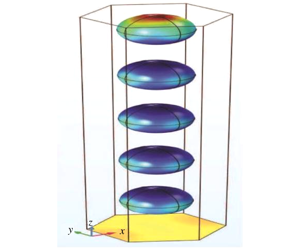Article contents
Influence of endothelial glycocalyx layer microstructure upon its role as a mechanotransducer
Published online by Cambridge University Press: 22 April 2020
Abstract

The endothelial glycocalyx layer (EGL) is a brush-like layer that lines the internal surfaces of blood vessels. It is thought to serve a number of physiological functions, including as a mechanotransducer of fluid loadings to the vessel wall. However, the fragility of the EGL makes it difficult to examine experimentally, and so there is much value in theoretical models that can help to explain the dynamical behaviour of the EGL. Most previous models have employed mixture theory to mechanically describe the layer, which treats the EGL as a isotropic linearly poroelastic layer. However, there is increasing experimental evidence to suggest that the EGL has a well-defined organisational structure that might not necessarily be well captured by such mixture theory descriptions. We therefore employ homogenisation theory to incorporate into the models some of the possible EGL microstructure suggested by the current biological literature. We explore how mechanotransduction varies under the different possible EGL microstructures, which potentially has important consequences to our understanding of how structural changes to the EGL might affect a vessel’s ability to respond to hemodynamical cues. We also find that, whereas mechanotransduction through the solid components of the EGL is dominated by the fluid tractions applied at the lumen–EGL interface, the component carried through its fluid phase is most sensitive to pressure gradients within the bulk EGL. This is relevant, since it is known that the underlying endothelial cells respond differently to these two different forms of mechanical loading.
JFM classification
- Type
- JFM Papers
- Information
- Copyright
- © The Author(s), 2020. Published by Cambridge University Press
References
- 4
- Cited by




